Introduction to fine wine investment
As fine wine gets older and rarer, it is expected to increase in value. This is the premise of fine wine investment: buy wine when it’s young, then sell it once it’s older and more valuable. Headlines are filled with stories of investors who bought wine at low prices then sold it years later for thousands. The possibility that wine, a complex drink that fascinates many people, could earn a substantial return, attracts many to wine investment. The following pages outline the basics of fine wine investment: how it works in practice, and the key trends that have defined the market over the past 20 years.
Fine wine investment in perspective
Wine appreciation and collection is no new phenomenon – it has been around for millennia. The ancient Greeks, Egyptians, Phoenicians and Romans were all big traders of wine; Charles II of England famously had Chateau Haut Brion in his cellar. The writings of Thomas Jefferson provide perhaps the first evidence of a premium charged for older wine. In 1787, he wrote that the 1786 vintage for top Bordeaux wines cost 1800 livres per tonneau compared to 2000 livres for the older 1783.
Today, fine wine has emerged as a popular alternative investment. It is a common practice to purchase a few cases for consumption and resell all or part of the collection later. Research conducted by Ledbury and Barclays Wealth and Management in 2012 indicates
that 28% of high-net-worth individuals own a collection of fine wine. Some estimates suggest that it accounts for approximately 2% of the wealth of the world’s most wealthy people.
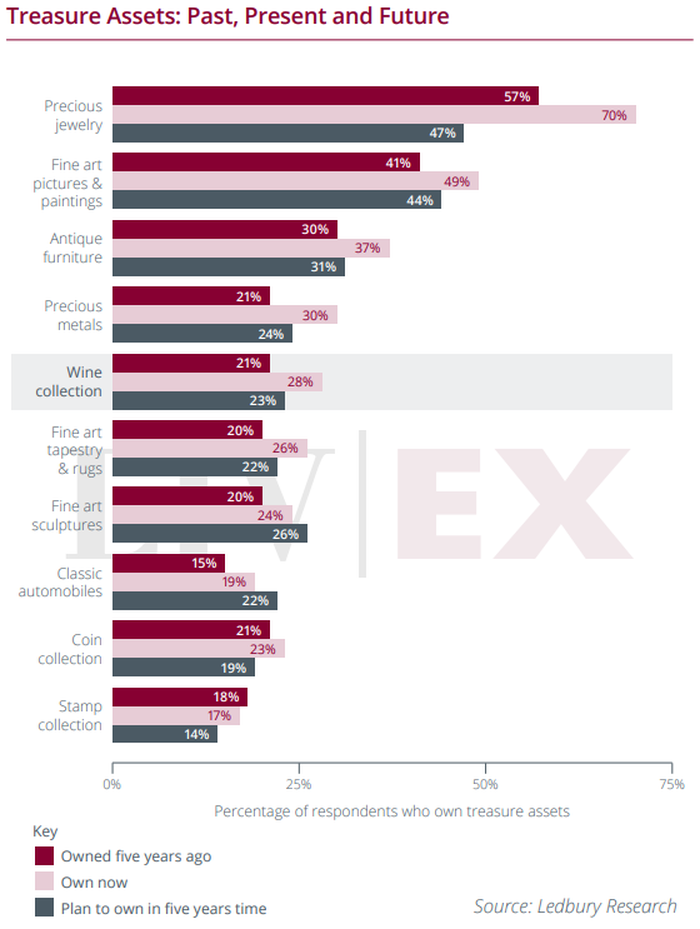
What’s the allure?
There are three main motivations for investing in find wine: Portfolio diversification, for its tangibility and liquidity, and for enjoyment.
Portfolio Diversifier
As an alternative assets, fine wine has historically shown little correlation to mainstream markets. When traditional markets fall, fine wine tends to hold steady. This means that it can act as portfolio diversifier, reducing the overall risk of an investor’s portfolio, delivering stability and growth, and protecting wealth.
This is pertinent in the current climate. In 2020, a turbulent year for all due to the global pandemic, fine wine delivered welcome stability. The Liv-ex 100 and the Liv-ex 1000 indices performed better than the FTSE 100 and the DAX – evidence of the market’s robustness during challenging times.
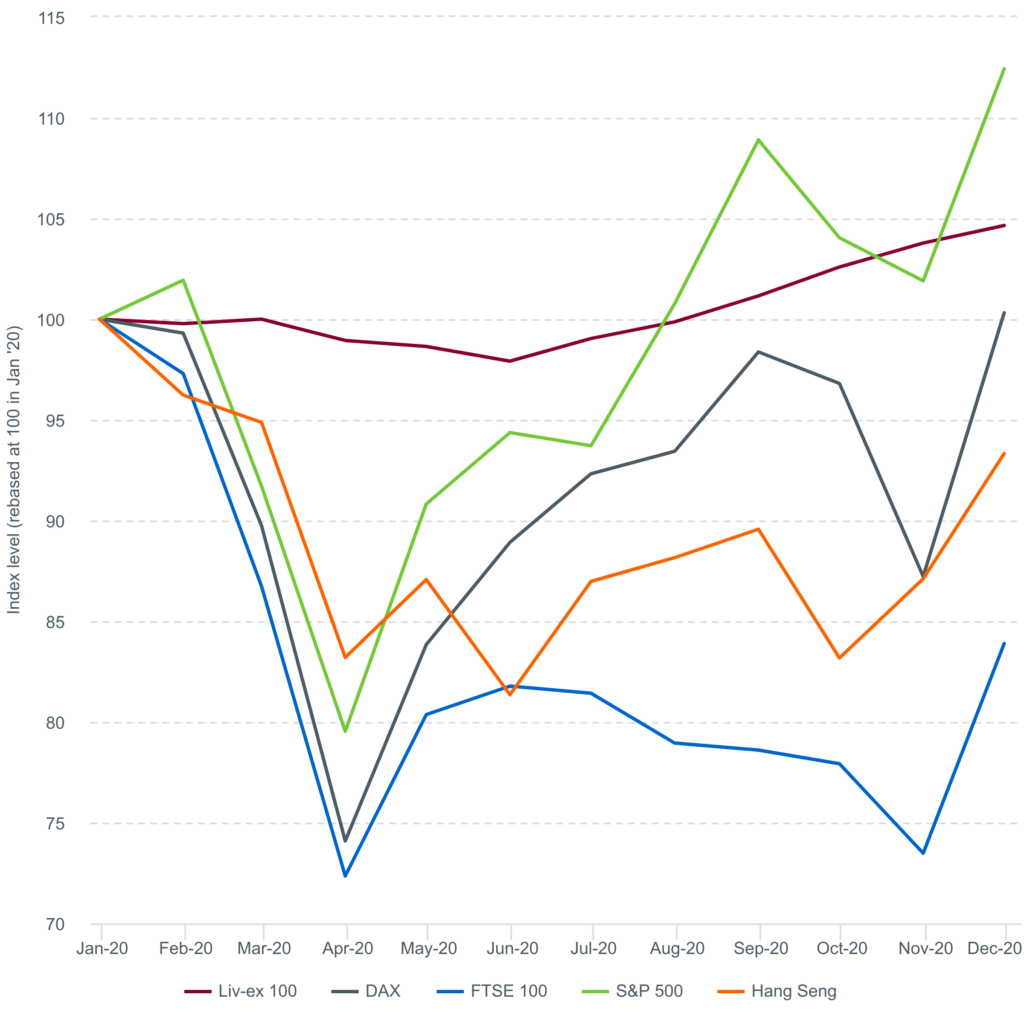
Liv-ex is the global marketplace for the wine trade. The fastest way to price, buy and sell wine.
rgt
Tangibility
The tangibility of fine wine also adds to its investment appeal. Physical assets are often perceived as offering a stable store of value in uncertain times. Stock markets can crash, businesses can close, and share prices can collapse – but tangible assets do not cease to exist (unless, in this case, they are drunk and enjoyed). In this sense, fine wine can be compared to real estate, but without maintenance costs, and without being reliant on a single economy. Fine wine can also be moved around and traded internationally. Fine wine can also be a tax efficient investment. As a ‘wasting’ asset – an item with a life span of no more than 50 years – most fine wine is exempt from capital gains tax. Although wine can be drinkable some 60 years later, most wine sales would not give rise to a potential tax liability, meaning that investors can enjoy more significant returns.
Passion investment
Despite the investment opportunities that exist, fine wine remains first and foremost a passion for many collectors. The latest report by thinktank ARENI Global, The future of fine wine consumers 2021, said: “Looking at the overall numbers, it appears that fine wine occupies a place of prestige in people’s lives, being used for formal occasions, business occasions and gifting. A minority of respondents— less than 30% in each country—said they bought
wine specifically as an investment.” This clearly shows that there is more to fine wine collecting than material returns
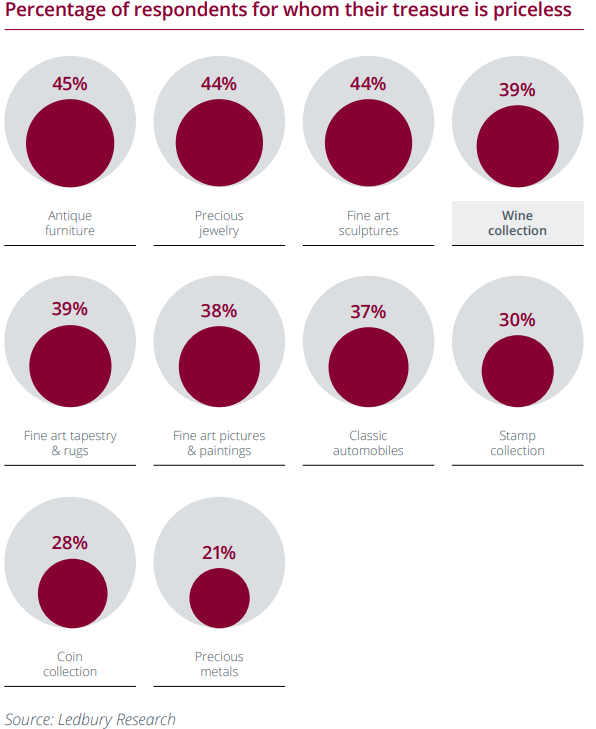
Wine is an example of people turning a passion into an investment.
Angie O’Leary, RBC Wealth Management – U.S.
How does fine wine investment work?
Accessing the market
Private investors can access the market via three main routes: merchants (retailers), auction houses, and wine funds
Fine wine merchants (retailers)
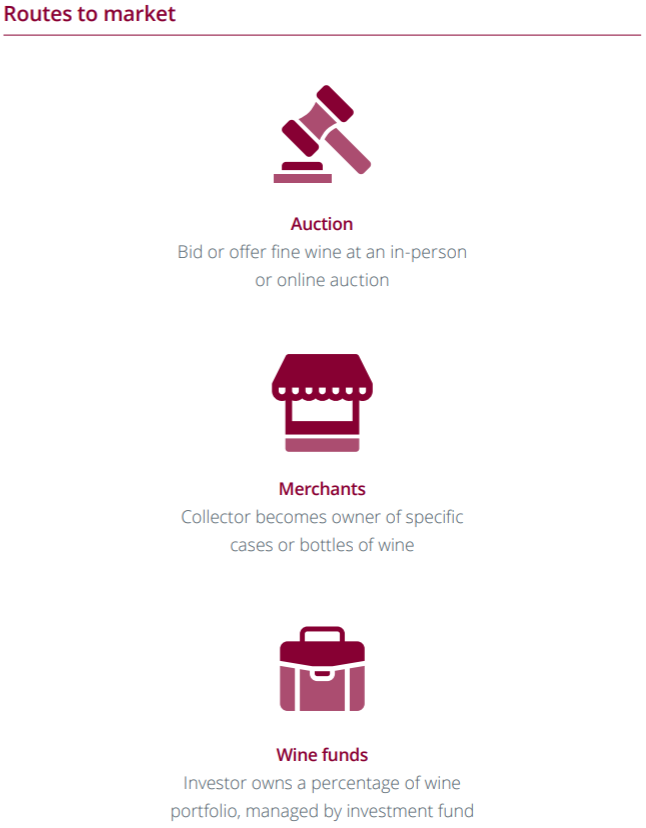
Fine wine merchants (retailers) The most common route is to purchase cases through a reputable wine merchant. The collector becomes the owner of specific cases or bottles of wine and can watch them increase – hopefully – in value, until he or she is either ready to drink or sell them. If the buyer chooses to sell the wine, merchants typically charge a fee of around 10% to complete the process. Because the asset will need to rise by more than this before the collector profits, wine is considered a long-term investment, rather than something that can be day-traded.
Auction houses
The second option is buying and selling wine at an auction. Well known auction houses like Sotheby’s offer in-person wine auctions throughout the year. Charity wine auctions such as the New York International Wine Auction (NYIWA) are also popular.
Auctions tend to specialise in old, rare wines but also in sales direct from producers. Whether for charity or profit, in-person wine auctions typically require buyers to pay commissions to the auction house (also known as buyer’s premiums). Percentages vary widely, between 10%-30%.
Auction represents an estimated 10-15% of the market.In the past year, online auctions have also gained popularity through sites like VinFolio and WineBid. These sites generally emulate the eBay format, offering time-limited auctions on a continuous basis. Costs for buyers vary widely, from free to 20%.
Wine funds
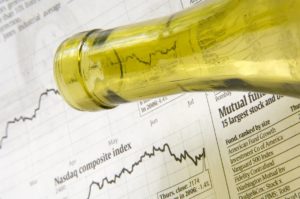
The third main route is to invest in a wine fund – a model at its apogee in the noughties – that has been seeing something of a comeback recently. Typically, those investing in a wine fund own a percentage of a portfolio of wine, rather than any individual cases (although some funds allow redemptions to be payable in wine).
Wine funds are like investment funds in that they are managed by fund managers who charge a management fee, and can identify and access opportunities in the market.
One drawback of these structures can be the minimum capital investment required, somewhat limiting them to the ultra-wealthy. However, new wine investment companies are democratising wine investment requiring significantly less money to get started. This has been facilitated by advances in machine learning and artificial
intelligence. Our report, The Wine Business of Tomorrow, provides a more in-depth overview of technological innovations driving these business models.
Storage
Investment grade wine should be stored safely and correctly to help protect its value. For long-term storage, this means holding the wine in a cool, dark place with minimal disturbance. In some parts of the world, home cellar storage is the norm. In others, specialist warehouses exist to provide optimum storage conditions for fine wine. Often, merchants will work with a warehouse supplier to store wine on behalf of their clients.
The UK’s in-bond warehousing system has helped it to become a global centre for fine wine trading. This is because wines can be bought and resold by collectors “in bond”, i.e. with no taxes or duties applying until the wine leaves the warehouse to be consumed. This makes trading particularly efficient.
Costs
Other than the price of the wine, investors need to be aware of additional costs such as transaction fees, storage, and insurance. The costs differ depending on location, investment source (wine fund, auction or merchant), and choice of storage solution.
In the UK, most wine merchants that offer professional (in-bond) storage charge a flat fee per case per year between £9-£15, including VAT and insurance. The table opposite illustrates what this means in practice. It shows gains for three of the most traded wines by value from Burgundy, Bordeaux and Italy since their release, taking the buyers costs into account.
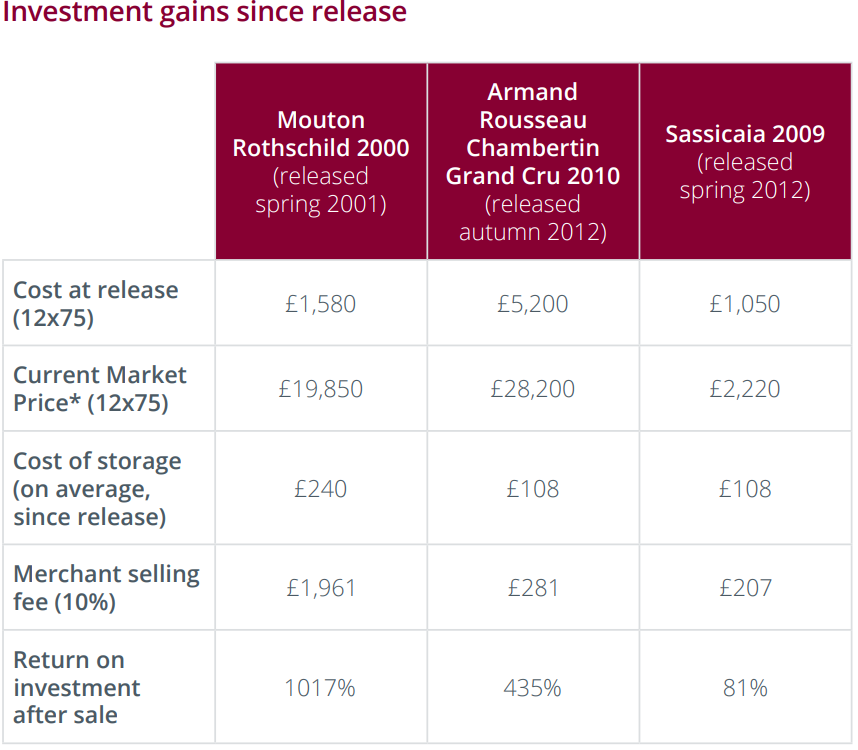
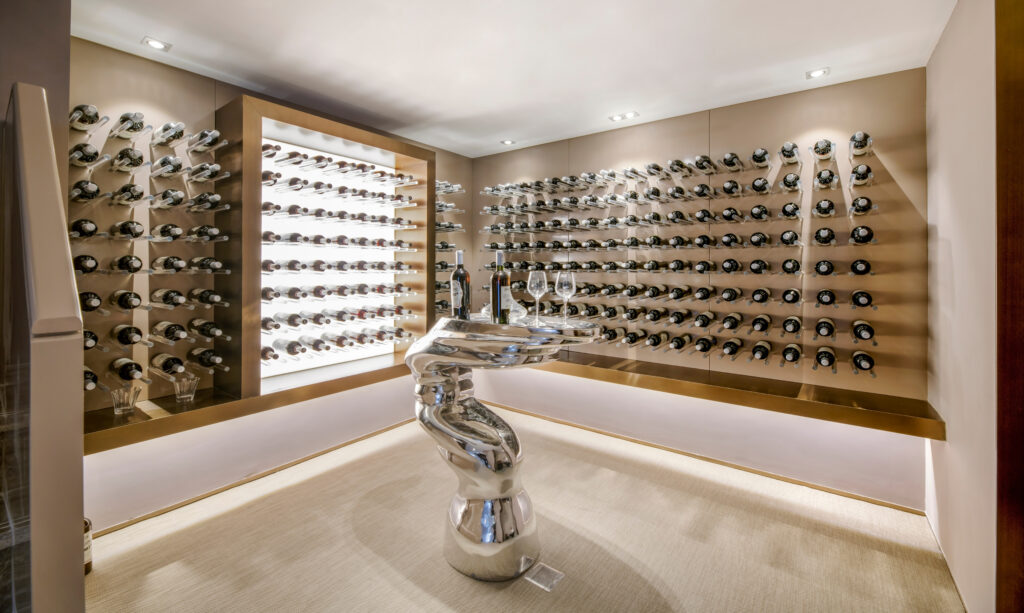
Costs and market share structure differ in other parts of the world. Bonded warehouses are a popular solution in Switzerland, where most estimate the storage costs based on the value of the assets.
Similarly, in the US, some warehouses charge a percentage of the total value of the collection for storage; around 1.5%. So on a collection worth $50,000, storage costs come in at $750. Other storage providers charge anywhere between $18 and $30 per case per month, with discounts usually available for larger volumes.
Renting a wine cellar is another solution, with process varying based on storage capacity. One popular storage provider in Hong Kong, for instance, charges from 450 HKD monthly for a locker (10 cases) to 5,980 HKD (200 cases). In most countries, the default option is to pay any relevant taxes at the time of purchase, then store at home or at other temperature-controlled storage facilities.
Those investing in a wine fund are also subject to charges. These include one-off subscription fees in some cases, annual management fees (from 1.5% to 2.5%), and performance fees based on the appreciation in the value of the wine investment that can amount to up to 20%. These charges cover storage and insurance.
Buy and sell with speed and confidence from and to the largest pool of trusted merchants worldwide…
The Role of Liv-ex
What is Liv-ex?
Liv-ex is the global marketplace for the wine trade. It is an independent membership organisation used by the majority of major fine wine merchants worldwide. It started in 2000 with 10 founding members. Today, more than 530 businesses worldwide trade on its platform.
Membership is available exclusively to wine trade professionals such as importer, distributors and retailers. They use it to price, buy and sell wine. No private collectors can trade on Liv-ex.
Standardised contracts and pricing transparency
Two important and related developments have contributed to the growth and increased efficiency of the fine wine market in the past two decades.
In 2001, the SIB (Standard in Bond) contract was introduced for transactions on Liv-ex. Wines sold under this contract must be in perfect condition and stored in bond, among other conditions. This had the dual impact of increasing confidence in trading and enabling accurate price tracking and valuations for wine.
Before SIB was introduced, it was impossible to know whether two transactions for the same wine could be compared. One transaction might be for stock in perfect condition; the next might have damaged labels. If a merchant based a valuation on the second, more recent transaction, there is a significant risk of under pricing. Standardising the data resolved this issue.
This new standardised valuation data, combines with increased data sharing online from the early 2000s onward, brought increased pricing transparency to the fine wine market. With it came trading confidence, greater pricing efficient, and increased liquidity in the market.
At the time of writing, there are a combined £80 million of committed bids and offers for wine on Liv-ex. All financial
transactions are managed by Liv-ex, and all stock that is traded on the platform passes through Liv-ex hubs to ensure trades are completed.
Informed markets create sophisticated buyers who make purchase decisions based on real and relevant data. Liv-ex plays a central role in this process.
– David Pearson, former Opus One CEO.
Wine investment trends
The performance of fine wine is best reflected in indices that track the prices of the most traded wines in the market.
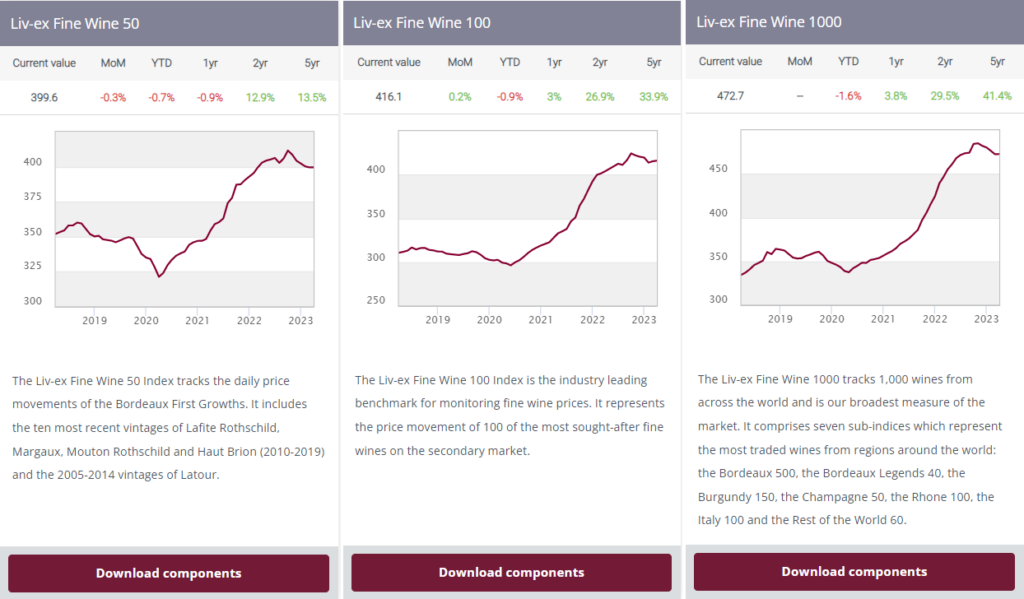
The fine wine market has experienced a number of cycles throughout history. Over the past 15 years, prices have shifted several times.
The industry benchmark Liv-ex 100 dipped 20% during the financial crisis, before climbing 70% by mid-2011 largely owing to the huge fiscal stimulus in China from 2009. Prices then fell from 2011 as buying in the Far East almost came to a halt. Weakened sterling contributed to a “Brexit” boost to the market from mid-2016 as international buyers capitalised on cheaper stock held in the UK.
In March 2020, the start of the Covid-19 pandemic led to small declines in fine wine prices, which then quickly recovered and gathered momentum in the second half of the year.
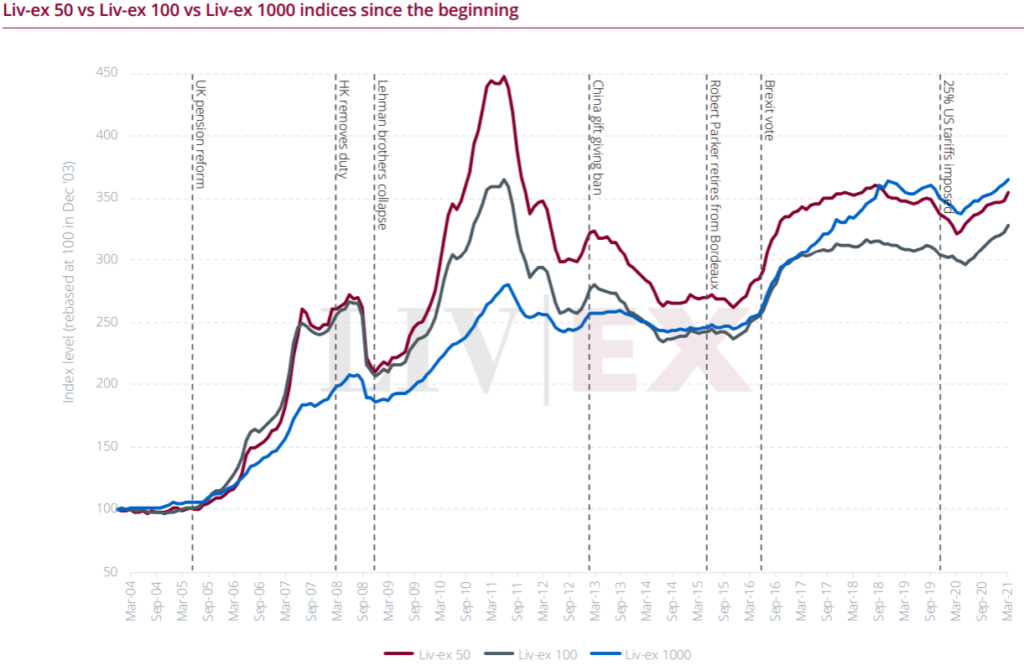
Regional investment trends
Wines from some regions have seen prices rise much faster than others. Burgundy has been the main riser in the past decade – insatiable demand for its top wines has driven prices into the stratosphere. The Burgundy 150 index is up 136% over this period. The second major theme has been the rise of Italy since 2016. It has benefitted from rising interest, strong vintage campaigns, and from being excluded from the 25% US tariffs which hit the market in late 2019.
The Champagne 50 is another index that has consistently delivered steady returns. It has risen 58% over the last five years driven by the brand power and prestige of the grandes marques Champagnes, widely available stock, global distribution and accessible price points.
Another interesting index is the rest of the “World 60, which tracks the performance of top American, Australian, Spanish and Portuguese wines. Its performance in the past year has been supported by Vega Sicilia’s ‘Unico’, Penfolds Grange and Taylor’s Vintage Port.
Although amongst the slowest risers, the Rhone 100 has delivered consistent returns while also representing the cheapest entry point into fine wine in the shape of Châteauneuf-du-Pape.
The broadening base of the secondary market has attributed to its stability and success over the last half decade.
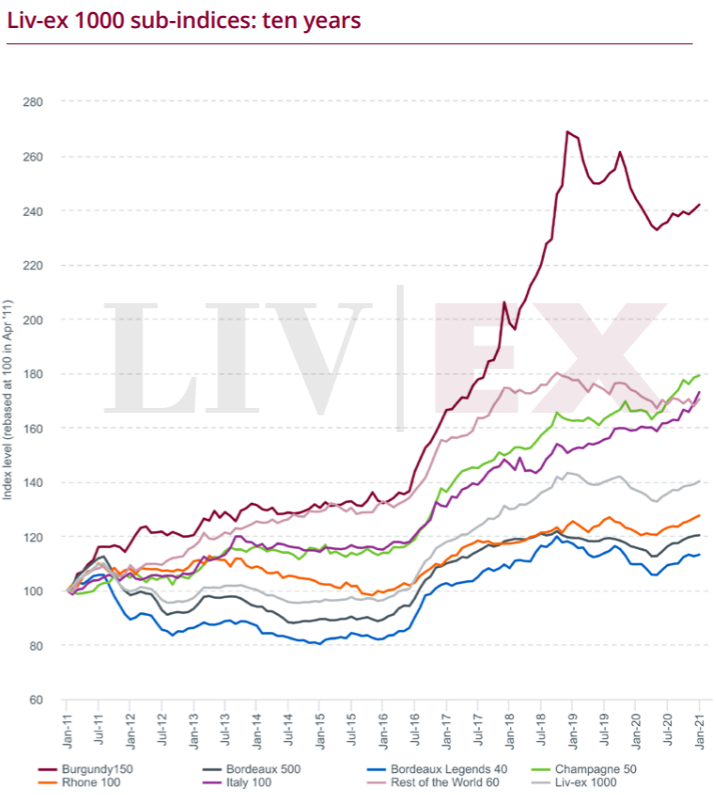
A broadening market
What’s happened in the last few years has been this broadening into Italians, Rhone, California…”
– Robert Joseph (Leading wine expert, consultant and producer)
Historically, classified growth Bordeaux dominated the fine wine investment market. In 2010, Bordeaux accounted for 96% of trade by value on Liv-ex, but the market has broadened considerably since then. Many investment opportunities now exist in other regions such as Champagne, Italy, the USA and elsewhere.
As the chart shows, trade for Burgundy and Italy on Liv-ex has been on the rise, respectively reaching 20% and 17% market shares by value. Although making up a much smaller share, the USA and Rest of the World (ROW) have seen some of the largest rises and now regularly find their wines among those most traded each week. Champagne and the Rhône have kept their relatively consistent share of trade for the past five years but, like the broader market, there has been a dramatic increase in the number of different labels from both regions that are now trading.
As for the future? New wines continue to enter the investment market. A tremendous scope exists for further development and potential opportunities in Spain, Australia, Chile, Argentina, South Africa and Germany.
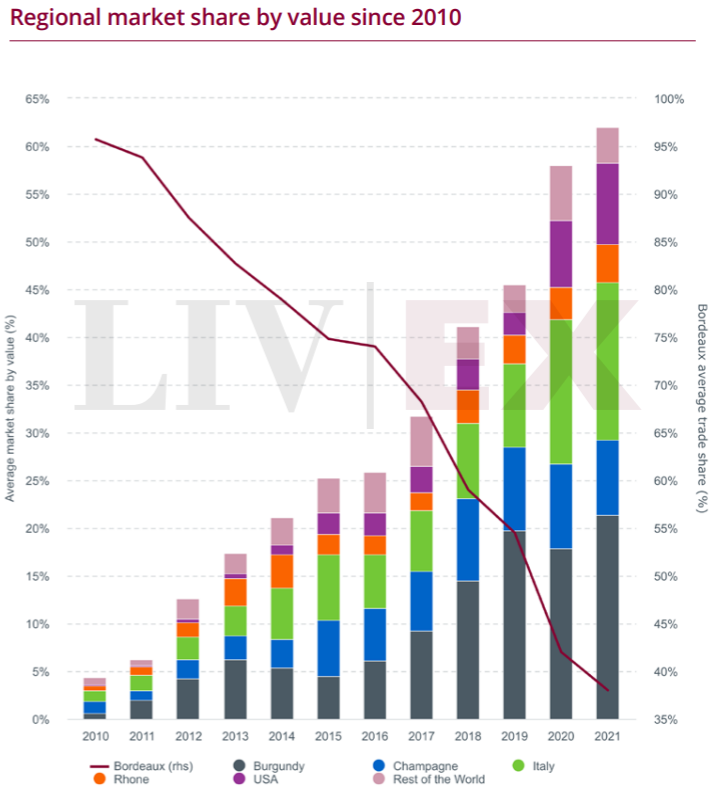
Power 100: Which wines are most important to the fine wine market?
The Power 100 is a list of the most powerful brands in the fine wine market. The latest list, published in December 2020, reflected the general shift in regional market share by value, with Bordeaux and Burgundy falling out of the rankings, and Italy, Champagne and Rest of the World, rising. Italy saw the largest gain in the number of brands represented, adding nine to reach a total of 17. Haut Brion was the only Bordeaux First Growth to appear in the
top 10. Leroy, the number one power brand, marks its third year in the top five.
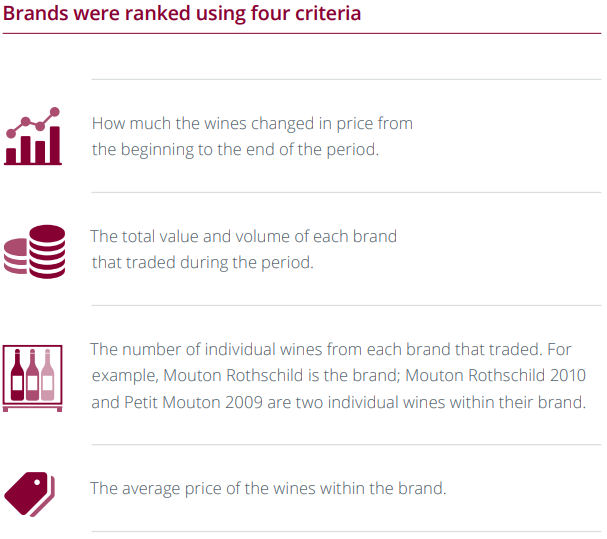
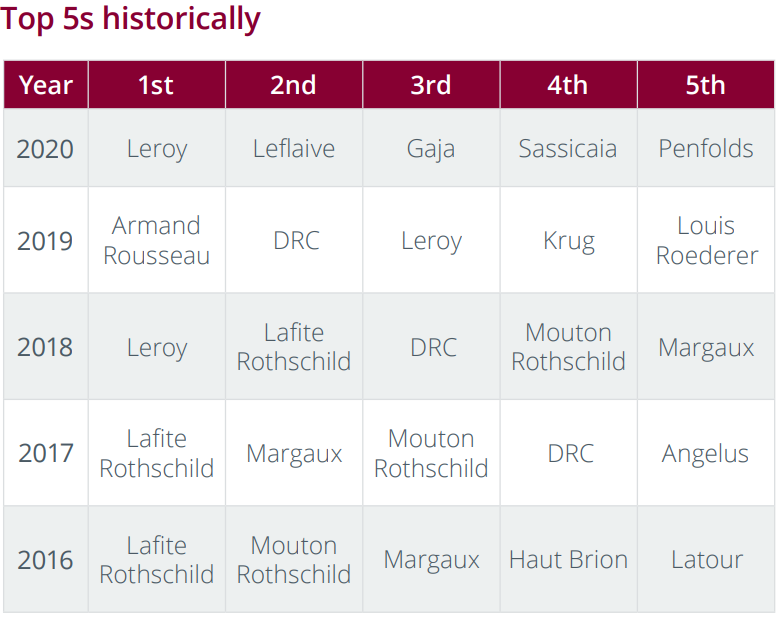
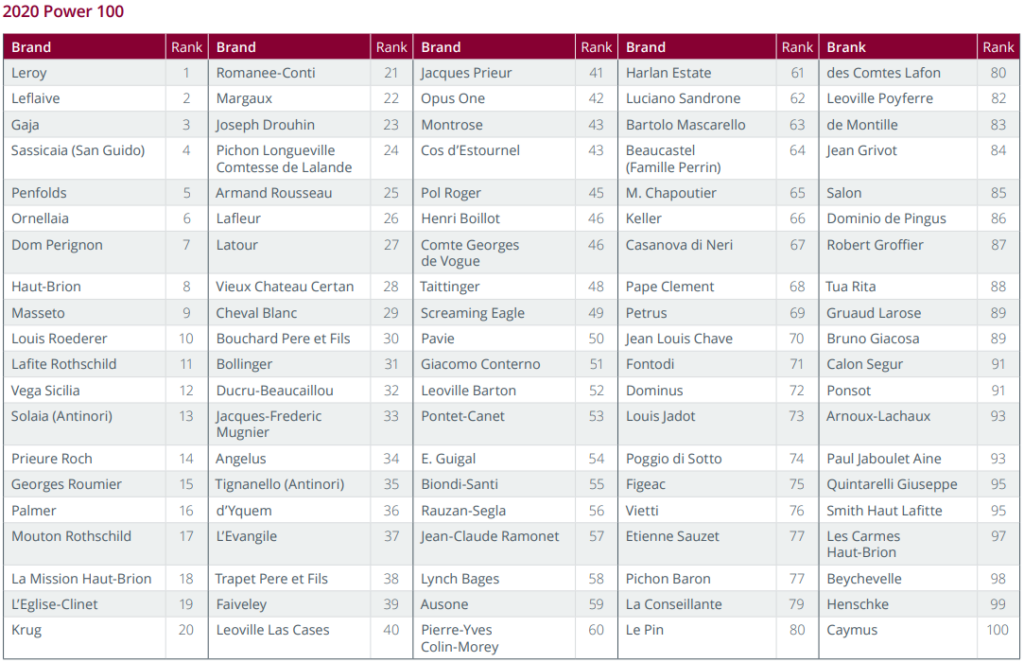
Liv-ex is the global marketplace for the wine trade. The fastest way to price, buy and sell wine.
How to get the right information on wine investment?
News, reviews and insights
Critics
Many collectors and traders consider critic scores vital in informing their buying and selling decisions. Historically, the
American critic Robert Parker, founder of The Wine Advocate, yielded the greatest influence over the price of wine. Parker’s power was such that a score ‘upgrade’ for a wine could result in rapidly rising prices. Since his retirement, greater attention is paid to a broader range of voices, many of whom provide specialised coverage on key wine regions. These include Neal Martin and Antonio Galloni at Vinous, Lisa Perrotti-Brown MW at The Wine Advocate, Jane Anson at Decanter, Jancis Robinson, James Molesworth at The Wine Spectator, James Suckling and Jeb Dunnuck, among others.
Industry Insights
Many fine wine merchants offer regional reports with key market trends and vintage overviews. Liv-ex’s blog and in-depth reports are another source of information on the latest trends. These reports and articles draw on transactional data, following the trading trends of more than 530 wine merchants worldwide.
News websites like The Drinks Business, Decanter, Bloomberg and the FT also provide regular coverage on fine wine investment.

Valuations
A recent Liv-ex survey amongst its global merchant membership revealed that price is the most important factor when deciding whether to purchase any given wine. Nowadays there is a wealth of pricing data online for investors to navigate, and various methods for creating accurate valuations.
These options differ in cost, time and efficiency. They are summarised below and discussed at length in our report,
How to value fine wine.
Methods for private individuals
Many wine merchants offer portfolio valuation as a complementary service direct from the market (Liv-ex). Speaking to a trusted merchant is a particularly good idea when investors
have rare or damaged stock. They can advise on adjustments to the Market Price. Private collectors can also use cellar management tools like Cellar Watch, which was founded by Liv-ex
and is now owned by Vinous. These tools display price information from the fine wine market, and allow investors to track wine values in real-time.
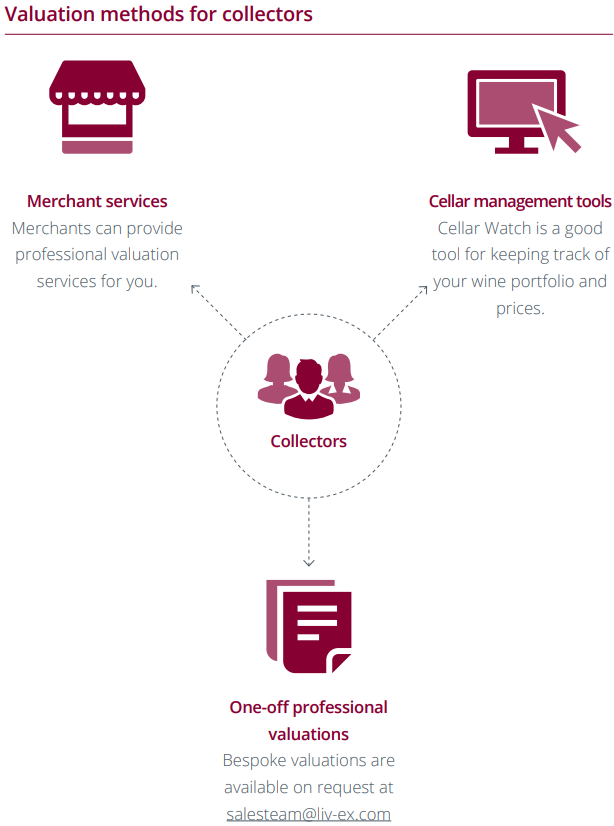
Methods for professionals
Pricing information is also available for free online in sites like Wine Searcher or Google. Anyone can open a web browser, search for a wine, and note down the advertised price. As a rule, this method isn’t recommended for non-professionals. Experience is required to make good judgements about which price points can be trusted, particularly for old and rare wines. It can be impossible to find wine at the advertised price, making that valuation inaccurate.
Many wine investment funds appoint Liv-ex as their official valuer for access to Mid-Price data which is uniquely based on transactional data – the most reliable source of valuation information. Businesses can request one-off valuations from Liv-ex by contacting [email protected]. Professionals also make use of web-based tools like Liv-ex’s Wine Matcher which quickly add valuation information using actual prices transacted on the fine wine market to wine lists. To produce a valuation, one needs an Excel document with the wine names and quantities.
Price valuations can also be automatically brought into a system using APIs. This removes the need for any manual intervention. Liv-ex’s pricing APIs bring prices directly into an Enterprise Resource Planning (ERP) or similar system, displaying them alongside your other product information for a wine. This is available in multiple currencies. With automation services, price data can be accessed alongside stock information in one place.
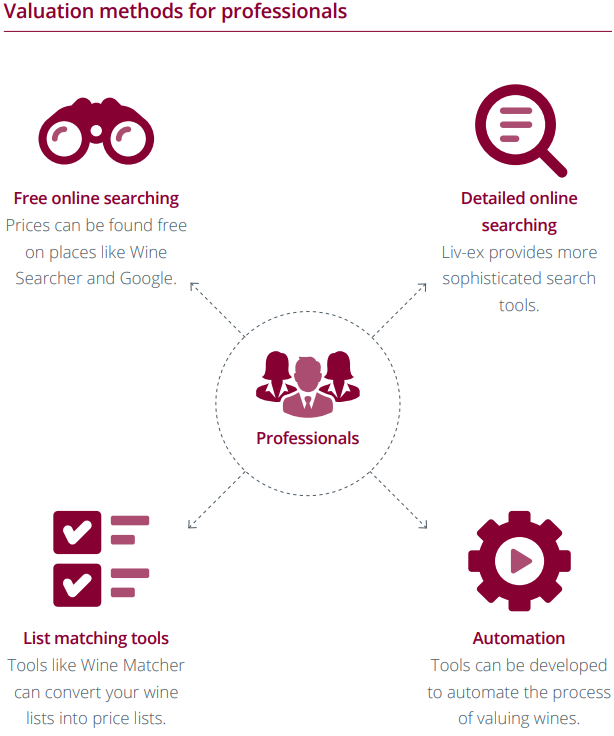
Concluding thoughts – A virtuous circle
More than just a stable and diverse source of returns, fine wine has long-enticed investors with its rich history and drinking pleasure. These investors have, in a way, also played a vital role in how the wine market functions at the top end.
Few producers have the finances to cellar large quantities of wine for extended periods of time. By investing in wine, collectors make it easier for buyers to find mature wine on the market. Without a secondary market and the possibility of price appreciation, there is little incentive for them to buy young wines, store them, and sell them later. It is thanks to the mechanisms of this market that such a healthy quantity of aged fine wine is readily available to anyone willing and able to pay – not just those who had an allocation 20 years ago.
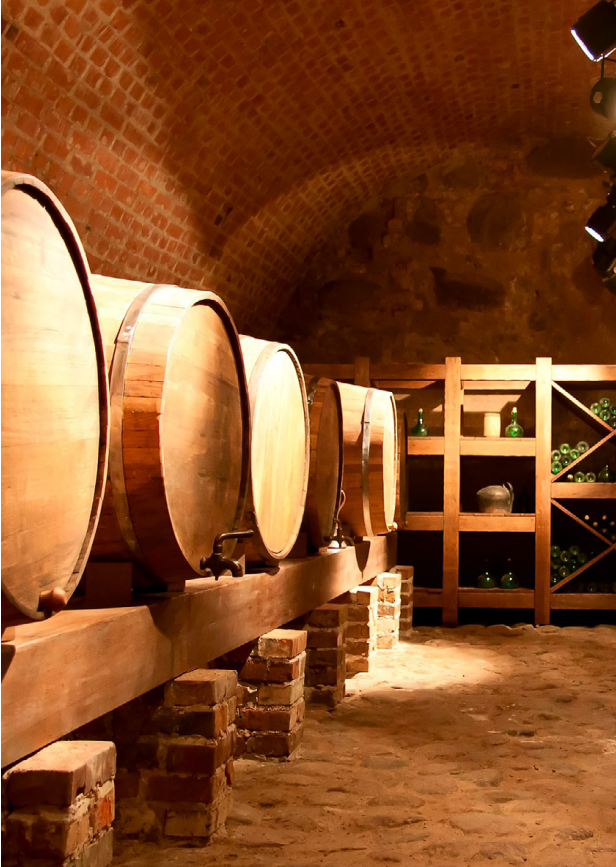
This report covered the fundamentals of wine investment: the allure behind it, the biggest trends that have come to define it, the routes to market, and some of the practicalities. Today, the investment opportunities in fine wine are broader and more diverse than ever before. And there is an ever-expanding pool of active market participants taking advantage of these opportunities and of the increased price transparency of the market. This is a trend that looks set to continue.
Buy and sell with speed and confidence from and to the largest pool of trusted merchants worldwide…
